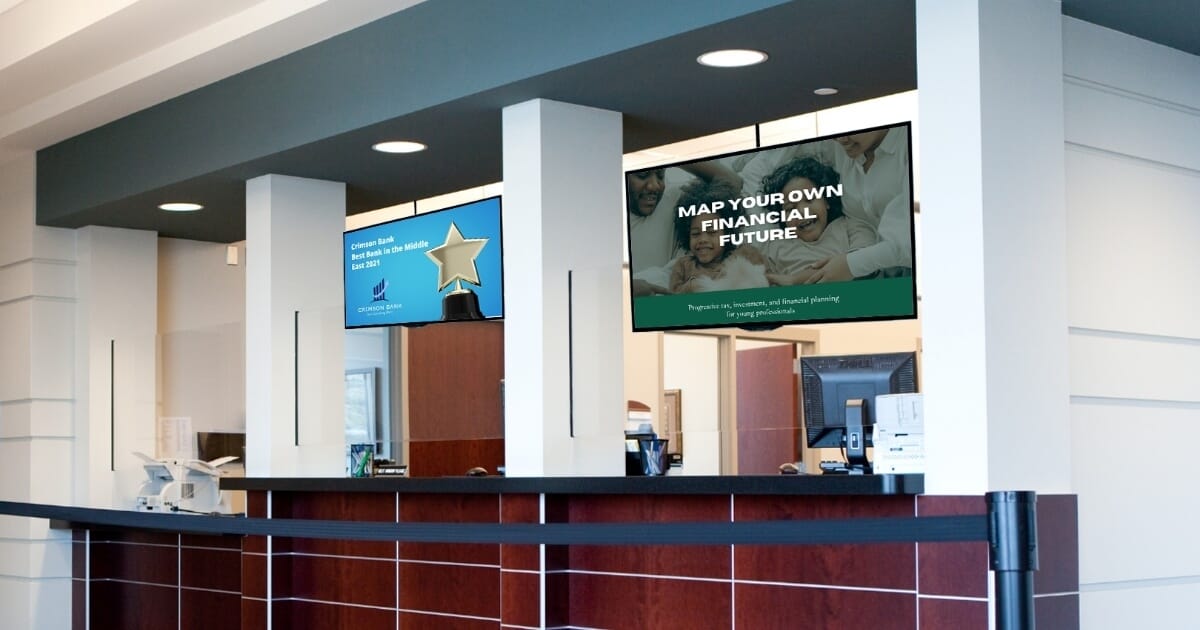In the current world and with the changing technology in the financial industry, the customer expectations keep rising. In the era of digitalization, the bank branches are trying to incorporate technologies for improving customer experience, efficiency and right experience inside the branch. Among such tools, one can distinguish digital signage – a promising instrument for communication that unites an opportunity to display dynamic visuals and up-to-date information. In bank branches, digital Signage is not a small luxury but a sign of progress and a way to enhance the customer experience and marketing as well as a tool for service delivery and enhancement of operational efficiency.
The Role of Digital Signage in Modern Banking
The new role of banking is not only about the transaction, but it is much more about a relationship between the bank and the customer. With the migration from physical services such as those involving the use of papers, the consumers’ perception and engagement with the banking service has changed. Although people can perform banking operations without visiting a bank through the Internet, the bank branch remains crucial for services that require face-to-face communication, like investment or mortgage. This is where digital signage can make that magic happen.
Enhancing Customer Engagement
Bank branch customers can spend their time waiting in queues, completing forms, or searching for information on products and services. Previous to this, a static poster or a printed flyer would have been created to tell consumers about new products. However, these content materials are usually old, repetitive, and do not grab the customers’ attention.
Digital signage on the other hand offers the dynamic, artistic solution. Multimedia can be presented in form of videos, animations, and interactive infographics, and the high-definition screens ensure that the information being presented is well presented. This is helpful in ensuring that the customers are informed as they wait in the branch making the experience in the branch a good one.
Improving the Waiting Experience
It is quite a nuisance to have to spend a lot of time waiting in a line when at a bank branch. Digital signage can assist with this issue by converting waiting time into an active and informative experience. Some indications that can be provided to the customers include the number of customers served in a particular counter, time taken to serve a certain counter, time taken to serve the next counter and the average time customers spend within the banking hall.
In addition, during wait times, this digital real estate can be employed to share a blend of interest, news, weather updates, social media feeds as well as promotional content related to banking products. For instance, if a customer is waiting for a teller, they may see content about a new savings account or mortgage offer and may have to ask more.
Digital Signage as a Marketing Tool
Another great marketing method that should be used in bank branches is digital signage. Since it is an online and an interactive platform, the content can be easily changed to accommodate the new offers, promotions, or changes in the regulatory framework, which eliminate the need for expensive printing services.
Real-time Targeted Messaging
The biggest strength of digital signage is therefore its real-time ability to deliver targeted messages. Banks are able to use analytical tools and other tools that segment the customers in the bank by demography in order to relay messages depending on the demography of the customers present in any branch at any given time. For instance, in the afternoons when elder people may visit the branch, the signs could be in regard to retirement saving or pension services. When junior business personnel come to have lunch, they can be reached with mobile banking applications, investment products, or digital payments.
Promoting Financial Literacy
Apart from the marketing function, banks play a social role of educating their customers on matters of finance. The use of digital displays can also present information in a form of educational content for instance on how to manage your finances, how to invest or how to avoid being a victim of fraud. This is not only valuable for the customers but also helpful for the bank to establish the image of the knowledgeable and caring financial advisor.
Improving Operational Effectiveness
Apart from the customer relations and marketing, the digital signage is also used in the branch of the bank to increase operational performance.
Reducing Perceived Wait Times
One of the main issues of the operational processes in many banks is the proper control of the customer flow and the minimization of the time that the customers think they are waiting. In addition, digital signage system can be synchronized with a queue management system to inform the customers of their current position in the queue thus the perceived long wait is not stressful. Also, the estimated time of services to be offered can also be posted by banks, to enable customers to manage their time well when attending the bank.
Organization and Enhancing Interaction with Employees
Another application of digital signage is the internal communication. For instance, in areas/rooms which are accessible only to employees of the bank, there is always a possibility to display on screens new goals/activities for the day, performance, new company information, etc. This facilitates communication within the staff, in order to make sure that they are always on track with the bank’s goals and operations.
Types of Content on Bank Digital Signage
Banks are therefore encouraged to embrace a number of content types so that the digital signage is as effective as it can be. The content must be frequently updated, interesting and informative. Below are some types of content that can be featured on digital signage in bank branches:
1. Product Promotions: Existing product promotions by the bank including credit cards, loans, or savings accounts promotions.
2. Customer Testimonials: Customer satisfaction and credibility statements of videos that promote their products.
3. News and Updates: Live updates of newspapers, magazines, business, stock exchanges, international forex rates, interest rates, and new banking rules.
4. Educational Videos: Information on how to use internet banking services, a mobile application, or financial planning materials.
5. Community Involvement: Making the bank to be involved in charity events or sponsorships within the area.
6. Seasonal Offers: Marketing of holiday loan programs or special interest rates on deposits to mention but a few.
Comparing Digital Signage with Traditional Displays: The Benefits
Cost efficiency and sustainability are two of the most important concepts that are not easy to understand in isolation of each other.
Compared to the normal posters and printed materials that are usually used in informing people, the digital signages are cheaper to update and replace once in a while. After it is installed in the bank, the content can easily be changed from a central system eliminating the use of physical materials and hence cutting on costs. Further, digital signage can be useful in the bank’s CSR agenda in that it can be designed to encourage environmentally friendly practices.
Flexibility and Adaptability
Digital signage does not require a person to go and change the images as opposed to posters that are fixed. Another factor is that the messages which are conveyed by the banks may vary depending on the time of the day, branches concerned, or on the promotion, etc. This flexibility helps to make sure that content is always right for the audience in question. For instance, during the lunchtime in a city branch, the signs may call for mobile banking while in a suburban branch it may be mortgage or family banking.
Enhanced Security Messaging
These challenges include the fact that banks have to regularly remind their customers about security measures required to protect their finances. Advertising on digital screens can be used to conduct security sensitization, inform customers on issues such as identity theft, phishing and how to protect their accounts. This is because the messages are most often communicated using visual and dynamic features of the digital signage.
Trends in Digital Signage: Their Relevance to the Banking Sector of the Future
Further development of digital technology means a great future for digital signs in the branches of the banks. Such features as touch screen interaction and AI based personalization are already emerging. In the future, the customers can use touch screens on the digital signages and select products, check their balance or get individual banking services based on their previous conduct.
AI integration could also allow digital signage to give future instructions, services or products to the customer depending on the interaction with other banking services. In addition, data analytics will remain important and enable banks to assess the impact of the digital signage content and its strategies to be applied.
Conclusion
The use of digital signage in bank branches is a potent strategy for changing the customer experience, increasing marketing effectiveness, and optimising business processes. Through providing timely and timely relevant content, banks are able to offer customers a more engaging, informative and indeed pleasant experience within branch environments. It is for this reason that digital signage shall remain a prominent feature in the future of branch banking as it tries to meet the need of digital efficiency and physical touch.





